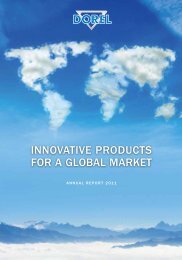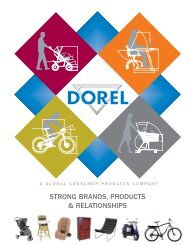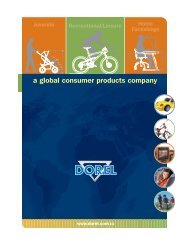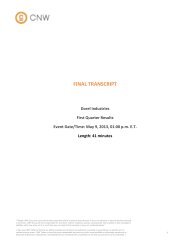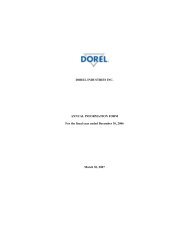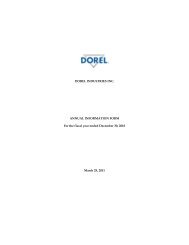2010 Annual Report - Dorel Industries
2010 Annual Report - Dorel Industries
2010 Annual Report - Dorel Industries
- No tags were found...
Create successful ePaper yourself
Turn your PDF publications into a flip-book with our unique Google optimized e-Paper software.
StandardsIAS 12:Income TaxesComparison between IFRS andCompany current accounting policieThe main relevant differences between IFRS and Canadian GAAPare the following:a) Unlike IFRS, under Canadian GAAP a future income taxasset or liability is not recognized for a temporary differencearising from the difference between the historical exchangerate and the current exchange rate translations of thecost of non-monetary assets and liabilities of integratedforeign operations.FindingsFindings by Difference:The Company has calculated anopening balance sheet adjustmentas at December 31, 2009 todecrease future income tax liabilitiesand increase retained earnings byapproximately $2.5 million.IAS 16:Property, Plantand Equipmentb) Under IFRS, potential tax exposures are analyzed individuallyand separately from the calculation of income tax, and theamount of tax provided for is the best estimate of the taxamount expected to be paid. Under Canadian GAAP, thegeneral recognition standard is “probable” or “more likely thannot”. Tax liabilities are measured using amounts “expected tobe paid to” tax authorities, using a single best estimate.c) Under IFRS, the difference between the tax base of the employeeservices received for stock-based compensation and its carryingamount (of $ nil) is a deductible temporary differences thatresults in a future income tax assets. Under Canadian GAAP,future income tax assets recognized in relation to stock-basedcompensation are not explicitly addressed.d) Under IFRS, the tax treatment of temporary differences onintercompany transfers is recognized as a deferred tax expenseor recovery and is calculated using the buyer’s rate. UnderCanadian GAAP, the tax impact is recognized as a current taxexpense or recovery and is calculated using the seller’s rate.The main relevant differences between IFRS and CanadianGAAP are:a) The possibility to evaluate assets at fair value at each balancesheet date.b) Componentization: parts of an asset with different useful liveshave to be amortized separately. This requirement exists underCanadian GAAP but it is further emphasized by IFRS.Based on the information collectedto date, this GAAP difference relatedto IFRS will not have an impact onthe company’s financial statements.The Company has calculated anopening balance sheet adjustmentas at December 31, 2009 todecrease future income tax assetsand decrease retained earnings byapproximately $1.0 million.The Company has calculated anopening balance sheet adjustmentas at December 31, 2009 toincrease future income tax assets by$1.7 million, increase income taxpayable by $0.3 million and to increaseretained earnings by approximately$1.4 million.Findings by Difference:Based on the information collected,none of these GAAP differencesrelated to fair value will have amaterial impact on the Company’sfinancial statements.The Company has not elected toevaluate assets at fair value at eachbalance sheet date. The Companydetermined that fixed assets do nothave to be materially componentizedfurther.<strong>Annual</strong> <strong>Report</strong> <strong>2010</strong> 23



